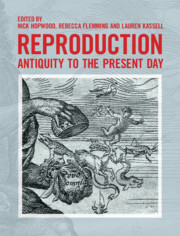Book contents
- Reproduction
- Frontispiece
- Reproduction
- Copyright page
- Dedication
- Contents
- Exhibits
- Illustrations
- Notes on the Frontispieces
- Contributors
- Acknowledgements
- Introduction
- Part I Inventing Generation
- Part II Generation Reborn and Reformed
- Part III Inventing Reproduction
- Part IV Modern Reproduction
- Part V Reproduction Centre Stage
- Epilogue
- Exhibits
- Exhibit 1 An Ancient Egyptian Fertility Figurine
- Exhibit 2 The Minotaur and Other Hybrids in Ancient Greece
- Exhibit 3 The Birth Horoscope of a Babylonian Scholar
- Exhibit 4 A Swaddled Infant Given to the Gods
- Exhibit 5 Phallic Fertility in Pompeii
- Exhibit 6 A Roman Embryo Hook
- Exhibit 7 A Uterine Amulet from the Roman Empire
- Exhibit 8 The Tree of Jesse
- Exhibit 9 The Hermaphroditic Hyena
- Exhibit 10 Medieval Birth Malpresentations
- Exhibit 11 A Medieval Birth Girdle
- Exhibit 12 Renaissance Art, Arousal and Impotence
- Exhibit 13 Monstrous Births and Diabolical Seed
- Exhibit 14 Jane Dee's Courses in John Dee's Diary
- Exhibit 15 A Placenta Painted and Engraved
- Exhibit 16 The Generative Parts of Women
- Exhibit 17 Pregnant Stones as Wonders of Nature
- Exhibit 18 A Birthing Chair
- Exhibit 19 A Painting of a Nursing Mother
- Exhibit 20 A Microscopical Salon
- Exhibit 21 A Crystal Womb
- Exhibit 22 Man-Midwifery Dissected
- Exhibit 23 Images of Human Embryos
- Exhibit 24 Population in the South Sea
- Exhibit 25 Aristotle's Masterpiece
- Exhibit 26 Spontaneous Generation and the Triumph of Experiment
- Exhibit 27 ‘Pity the Poor Mother!’
- Exhibit 28 Condoms
- Exhibit 29 Pedigree of a ‘Schizophrenic Family’
- Exhibit 30 Populations, Genetics and Race
- Exhibit 31 Menstrual-Cycle Calendars
- Exhibit 32 Pregnancy Testing with Frogs
- Exhibit 33 Technologies of Adoption Matching
- Exhibit 34 ‘Drama of Life before Birth’
- Exhibit 35 Our Bodies, Ourselves
- Exhibit 36 Z.P.G.
- Exhibit 37 Cloned Frogs
- Exhibit 38 ‘It's a Girl’
- Exhibit 39 Developmental Origins of Health and Disease
- Exhibit 40 The Room of the Ribbons
- Select Bibliography
- Index
- References
Exhibit 2 - The Minotaur and Other Hybrids in Ancient Greece
from Exhibits
Published online by Cambridge University Press: 16 November 2018
- Reproduction
- Frontispiece
- Reproduction
- Copyright page
- Dedication
- Contents
- Exhibits
- Illustrations
- Notes on the Frontispieces
- Contributors
- Acknowledgements
- Introduction
- Part I Inventing Generation
- Part II Generation Reborn and Reformed
- Part III Inventing Reproduction
- Part IV Modern Reproduction
- Part V Reproduction Centre Stage
- Epilogue
- Exhibits
- Exhibit 1 An Ancient Egyptian Fertility Figurine
- Exhibit 2 The Minotaur and Other Hybrids in Ancient Greece
- Exhibit 3 The Birth Horoscope of a Babylonian Scholar
- Exhibit 4 A Swaddled Infant Given to the Gods
- Exhibit 5 Phallic Fertility in Pompeii
- Exhibit 6 A Roman Embryo Hook
- Exhibit 7 A Uterine Amulet from the Roman Empire
- Exhibit 8 The Tree of Jesse
- Exhibit 9 The Hermaphroditic Hyena
- Exhibit 10 Medieval Birth Malpresentations
- Exhibit 11 A Medieval Birth Girdle
- Exhibit 12 Renaissance Art, Arousal and Impotence
- Exhibit 13 Monstrous Births and Diabolical Seed
- Exhibit 14 Jane Dee's Courses in John Dee's Diary
- Exhibit 15 A Placenta Painted and Engraved
- Exhibit 16 The Generative Parts of Women
- Exhibit 17 Pregnant Stones as Wonders of Nature
- Exhibit 18 A Birthing Chair
- Exhibit 19 A Painting of a Nursing Mother
- Exhibit 20 A Microscopical Salon
- Exhibit 21 A Crystal Womb
- Exhibit 22 Man-Midwifery Dissected
- Exhibit 23 Images of Human Embryos
- Exhibit 24 Population in the South Sea
- Exhibit 25 Aristotle's Masterpiece
- Exhibit 26 Spontaneous Generation and the Triumph of Experiment
- Exhibit 27 ‘Pity the Poor Mother!’
- Exhibit 28 Condoms
- Exhibit 29 Pedigree of a ‘Schizophrenic Family’
- Exhibit 30 Populations, Genetics and Race
- Exhibit 31 Menstrual-Cycle Calendars
- Exhibit 32 Pregnancy Testing with Frogs
- Exhibit 33 Technologies of Adoption Matching
- Exhibit 34 ‘Drama of Life before Birth’
- Exhibit 35 Our Bodies, Ourselves
- Exhibit 36 Z.P.G.
- Exhibit 37 Cloned Frogs
- Exhibit 38 ‘It's a Girl’
- Exhibit 39 Developmental Origins of Health and Disease
- Exhibit 40 The Room of the Ribbons
- Select Bibliography
- Index
- References
Summary
- Type
- Chapter
- Information
- ReproductionAntiquity to the Present Day, pp. 672Publisher: Cambridge University PressPrint publication year: 2018

